An early-ripening hybrid variety from Siberian breeders - the Ob Domes tomato and reviews from summer residents about these tomatoes
Dome-type tomatoes have an unconventional appearance for a tomato: they have a dome-shaped shape rather than the usual round one. One of these types is the Ob domes.
This is an early ripening hybrid with a high fruiting rate and good disease resistance. But his main merit is his ability to adapt and survive in harsh Siberian conditions, without requiring special attention or careful care. The variety is rightfully considered the best discovery of Russian selective science.
Characteristics and description of the variety
Bred by Siberian breeding scientists of the agrotechnical company "Siberian Garden". Recommended for cultivation in open ground and in greenhouse conditions.
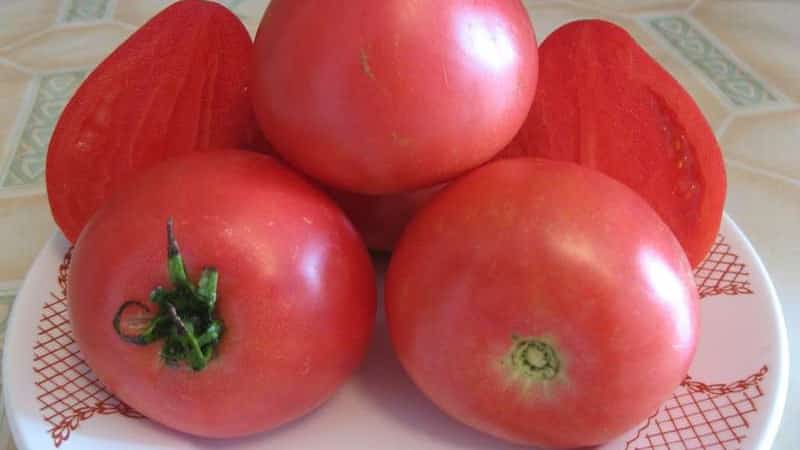
Determinate bush, height no more than 60 cm. In a greenhouse it reaches up to 70 cm.
Early ripening hybrid 95-100 days pass from the moment of sowing the seeds until the fruits are fully ripened.
Productivity is high, up to 5 kg of vegetables are harvested from 1 bush, subject to planting 5-6 seedlings per 1 sq. m.
Requires a mandatory garter, even with small growth and obligatory moderate stepsoning.
Resistant to most common diseases of the nightshade family. Well adapted to unfavorable climatic conditions.
The fruits are medium-sized, weighing from 200 g to 260 g. The color is bright red or raspberry pink. The shape is dome-shaped, similar in appearance to a persimmon. The peel is dense. The taste is sweet. Ripe vegetables contain a large amount of vitamins.When ripe, they are not prone to cracking.
Universal in use. Suitable for canning, pickling, marinade and tomato products. An excellent base for salads, first and second courses.
Ripe vegetables are subject to long-term storage and tolerate long-term transportation well without loss of appearance and taste.
Read also:
Simple and trouble-free tomato “Khlynovsky” to care for
Delicious salad tomato with a sweet honey taste - “Pink Elephant” tomato
Large tomatoes with sweet, juicy flesh: Buffalo Heart tomato
How to grow seedlings
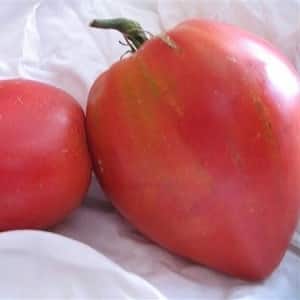 Sowing of seeds is carried out 50-55 days before planting seedlings in the ground.
Sowing of seeds is carried out 50-55 days before planting seedlings in the ground.
To accelerate germination, seeds are treated with a growth stimulant.
The soil mixture is prepared in advance from garden soil, washed river sand, ash and peat. Then the prepared mixture is laid out in containers.
You can plant both in a common wooden box and in individual containers: peat or seedling pots, plastic glasses.
Seed material is placed in grooves 1 cm deep. Level the soil on top, moisten it with a spray bottle and cover the containers with glass or film.
Before emergence, the optimal temperature is considered to be +23-25 degrees. Until germination, the seeds are kept in a dark room.
After the first shoots appear, the covering material is removed and the containers are moved to a lighted place, on the windowsill.. If there is not enough light, fluorescent lamps are used as additional lighting.
Young bushes respond well to feeding. As soon as the first shoots appear, complex fertilizers are applied to the soil. As the surface layer of soil dries, the seedlings are watered with warm water.
When 2 true leaves appear, pick. If the seeds are sown in a common box, then the sprouts are planted in separate containers. Picking helps select stronger plants and promotes the development of the root system.
2 weeks before transplanting into open ground, the seedlings are hardened. The hardening procedure involves staying outside for several hours during the daytime. At the same time, the temperature is reduced to 13 degrees in the room where the seedlings are brought in overnight. The time spent outside gradually increases to 24 hours.
How to grow tomatoes
After 50 - 55 days, the seedlings are transplanted into open beds. If possible, the tomato bed is located in a sunny place, protected from the wind.
Reference! The best predecessors for tomatoes are carrots, greens, cabbage, and legumes. After them, the earth is filled with nutrients necessary for the growth and development of tomatoes.
Planting pattern: 50 cm – distance between plants; 40 cm – row spacing.
For 1 sq. m place up to 6 bushes, since the plants are compact and low-growing.
A week after transplantation, the tomatoes are watered and fed with organic or mineral fertilizers. An infusion of mullein is suitable as an organic substance; it is used in a dilution of 1:15 so as not to burn the root system.
Tomato loves abundant watering, once every 7-10 days..
After watering, the soil is loosened, hilled up and weeds with roots are removed.. Mulching helps keep the beds moist longer.
Reference! The variety is watered with warm, settled water heated in the sun.
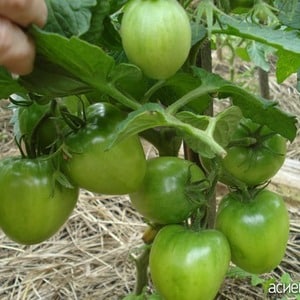 Culture needs obligatory garter. They are often tied to several stakes at once, since the branches are hung with fruits.To do this, when transplanting seedlings, several wooden stakes or metal rods are installed next to each bush. Sometimes they are tied to tensioned ropes.
Culture needs obligatory garter. They are often tied to several stakes at once, since the branches are hung with fruits.To do this, when transplanting seedlings, several wooden stakes or metal rods are installed next to each bush. Sometimes they are tied to tensioned ropes.
Stepchildren are removed only up to the first brush. The maximum fruiting rate is observed when the plant forms several stems. In open ground the crop is grown in 4-5 stems, in a greenhouse it is formed in 3-4 stems.
Feed twice during the entire growing season. Organic or complex mineral fertilizer containing nitrogen, phosphorus and potassium is fed during mass flowering. During ripening, fertilizing is carried out, consisting of phosphorus and potassium fertilizers. This technique improves the taste of tomatoes, making them sweeter and more aromatic. While the fruit is pouring, stop watering and loosening the soil.
Reference! The Urals are considered the best region for growing tomatoes. Ob Domes.
Diseases and pests
Despite the resistance to various diseases embedded in the genes, the tomato sometimes turns out to be powerless against infections and pests. Sometimes, even with proper and timely care, summer residents complain about crops being damaged by one or another disease, blaming low-quality seeds, stupid sellers and, in general, the whole world, in which there are only Colorado potato beetles, mole crickets and various molds. But this is the law of Nature, natural selection, which forces pests to adapt even to the most powerful organisms in order to survive themselves.
Powdery mildew affects crops in a greenhouse. The leaves become covered with a white coating, wither and fall off. The following drugs help to cope with it: “Quadris”, “Topaz” and sodium humate (1 g per 1 liter of water).
Anthracnose is a fungal disease. Leaves and fruits suffer.The foliage withers, falls, vegetables become covered with brown spots. Drugs will help in the fight against it: “Oxychom” or copper sulfate.
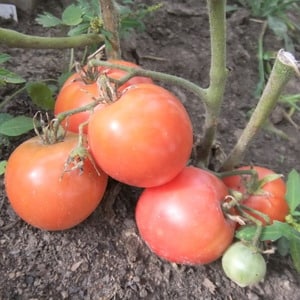 I must say that The main cause of fungal diseases is high humidity. Therefore, it is important to prevent the beds from becoming waterlogged, much less moisture stagnating in them. It is more difficult in rainy summers when moisture control is impossible.
I must say that The main cause of fungal diseases is high humidity. Therefore, it is important to prevent the beds from becoming waterlogged, much less moisture stagnating in them. It is more difficult in rainy summers when moisture control is impossible.
Dangerous pest of tomatoes - gnawing cutworm. This butterfly itself is not dangerous, but its caterpillars feed on plants and fruits. To prevent egg laying, the crop is treated with wormwood infusion with the addition of ash and liquid soap.
The Colorado potato beetle and slugs eat leaves and actively reproduce. The larvae and insects themselves are collected by hand. To prevent slugs, tobacco is sprinkled around the plants. They are also good at the smell of beer, so they set up traps for slugs by pouring a little beer into them.
Other varieties of tomatoes:
The nuances of growing in open ground and in a greenhouse
In the greenhouse, the crop is planted with 3-4 seedlings per 1 square meter. m. This is due to the fact that the height of the plant in the greenhouse is higher than its street counterparts and reaches 70 cm.
The mass of greenhouse vegetables can reach 300 g. Productivity up to 6 kg per bush.
In protected soil, the plant is grown in 3 or 4 stems, while in unprotected soil they form 5 stems.
In open ground, the crop is less susceptible to infectious outbreaks, according to numerous reviews, Obskie Dome tomatoes are usually healthy all season long. In a greenhouse, due to high temperatures and high humidity, plants are often attacked by mold. Regular ventilation will get rid of it.
Reference! If you plant nasturtium, dill, and marigolds next to tomatoes, the release of phytoncides will help inhibit the growth of fungi.
Harvesting and application
The first tomatoes are harvested in July, fruiting continues until beginning of September.
The universal use of vegetables in cooking allows you to use them as soon as your imagination dictates. They are good in fresh summer salads, in vegetable dishes, in soups, and ideal when baked with meat products. Moreover, they retain their taste perfectly, complementing other vegetables.
Suitable for salting, marinade, canning. Tomato products do not lose any taste at all; they are used to prepare lecho, juices, pasta, ketchup, and adjika.
Tomatoes can be stored for a long time and tolerate long-distance transportation well. If we add a high quantitative indicator to this fact, then culture can well be considered for commercial purposes.
Advantages and disadvantages
The variety has a lot of positive qualities. However, there is nothing surprising here if we are talking about a well-adapted early ripening hybrid:
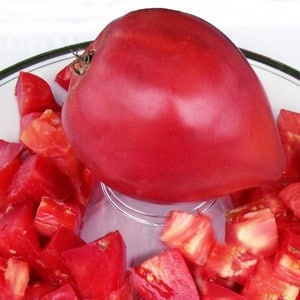 the ability to grow and develop in harsh conditions;
the ability to grow and develop in harsh conditions;- resistance to temperature changes;
- high resistance to major diseases;
- high fruiting rate;
- early ripening;
- ease of care;
- low stature of the crop;
- possibility of growing without a greenhouse;
- excellent taste of fruits;
- not prone to cracking;
- versatility in cooking;
- long storage;
- excellent transportability.
Of the negative aspects, only:
- the need for mandatory garter;
- the need for moderate stepsoning.
Farmer reviews
Gardeners unanimously evaluate the Ob domes as a high-quality tomato crop, which will not let you down either in the cold or in the heat and will always reward you with a generous harvest. Many people highly appreciate the taste of vegetables, noting their pleasant sugar content, which once again confirms the similarity with persimmons, and not only in appearance.
Here are some reviews from summer residents:
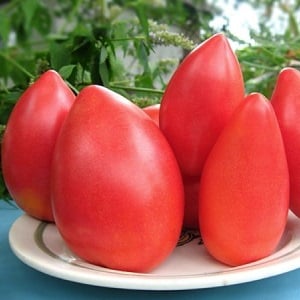 Valentina, Kostroma: “The hybrid is the best in my collection. Tomatoes are sweet, aromatic, well suited for making juices, purees, and salads.
Valentina, Kostroma: “The hybrid is the best in my collection. Tomatoes are sweet, aromatic, well suited for making juices, purees, and salads.
It’s easy to care for; you just need to remove the shoots up to the first cluster, tie them up, feed them and water them. I am pleased".
Konstantin, Bykovo: “I planted tomatoes in a greenhouse. The first fruits were collected in early July. The plants did not get sick and grew well. I fed it twice a season. There are a lot of vegetables. I will definitely plant more".
Ekaterina, Rostov-on-Don: “I grow it in open ground. Due to its small stature, it is easy to care for. But I make sure to regularly water, feed and tie it up. Always with the harvest".
Conclusion
The advantages of the hybrid are so obvious that there is no doubt about its popularity. A high level of adaptation to any climate, large yields, easy care, and disease resistance are the main aspects that vegetable growers rely on when choosing a crop. Siberian selection is especially important for residents of cold regions, where not every crop can take root and produce offspring in the short and cool summer.